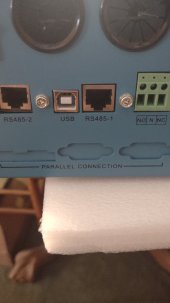I have been planning out my RV install and looking at all-in-one units.
I had my sights set on an MPP LVX6048, but I just ran across this unit:
https://sungoldpower.com/collections/all/products/5000w-48v-solar-charger-inverter
Model designation is SPH504880A
The unit is $799 but there is a 10% discount until the end of June, $720 total. Shipping is free.
This seems like a really great deal for the specs.
Pros:
- 500Voc max for solar
- 5kw inverter output
- 120V direct output (no auto transformer required)
- UL 1741
- Gen start dry contact, RS485, other goodies similar to MPP
Cons:
- only 40A battery charge from grid AC
- high frequency
- no 240V/split
- not parallel capable (I think?)
Has anyone run this unit, or care to comment on possible concerns?
Which MPP Solar unit would be the closest match? Maybe the LV5048?
I have the impression that SunGoldPower units are just another Voltronics rebrand, and usually come in very similar or exactly the same as MPP Solar cross referenced models. I have seen mostly positive reviews online, and I haven't come across a lot of complaints or concerns, like for some of the discount brands e.g. PowMr.
The only things that are missing from this system that I would like are 240V split phase and parallel capability, both for future needs, nothing I care about right now.
The LVX6048 shipped will be about $2200 CAD for me, this SunGoldPower will arrive for around $1050.
Too good to be true?
I had my sights set on an MPP LVX6048, but I just ran across this unit:
https://sungoldpower.com/collections/all/products/5000w-48v-solar-charger-inverter
Model designation is SPH504880A
The unit is $799 but there is a 10% discount until the end of June, $720 total. Shipping is free.
This seems like a really great deal for the specs.
Pros:
- 500Voc max for solar
- 5kw inverter output
- 120V direct output (no auto transformer required)
- UL 1741
- Gen start dry contact, RS485, other goodies similar to MPP
Cons:
- only 40A battery charge from grid AC
- high frequency
- no 240V/split
- not parallel capable (I think?)
Has anyone run this unit, or care to comment on possible concerns?
Which MPP Solar unit would be the closest match? Maybe the LV5048?
I have the impression that SunGoldPower units are just another Voltronics rebrand, and usually come in very similar or exactly the same as MPP Solar cross referenced models. I have seen mostly positive reviews online, and I haven't come across a lot of complaints or concerns, like for some of the discount brands e.g. PowMr.
The only things that are missing from this system that I would like are 240V split phase and parallel capability, both for future needs, nothing I care about right now.
The LVX6048 shipped will be about $2200 CAD for me, this SunGoldPower will arrive for around $1050.
Too good to be true?





